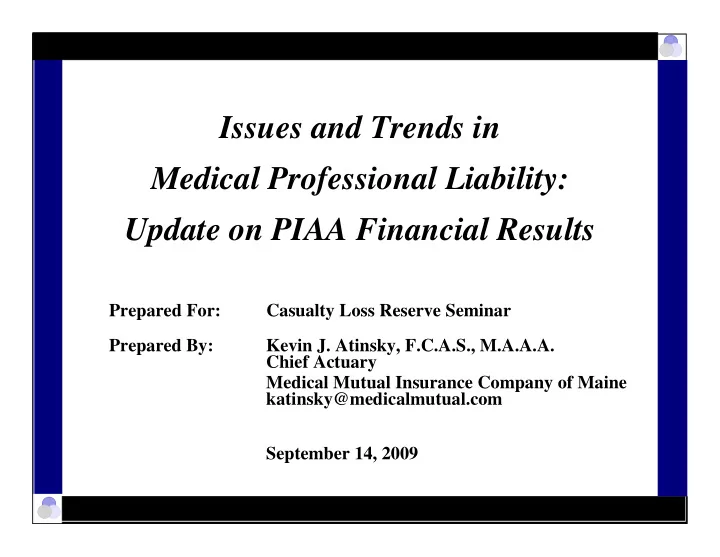

Issues and Trends in Medical Professional Liability: Update on PIAA Financial Results Prepared For: Casualty Loss Reserve Seminar Prepared By: Kevin J. Atinsky, F.C.A.S., M.A.A.A. Chief Actuary Medical Mutual Insurance Company of Maine katinsky@medicalmutual.com September 14, 2009
Disclosures Content of presentation is based on 2nd Quarter 2009 edition of The Physician Insurer , trade publication of the Physician Insurers Association of America (PIAA); article entitled “Industry Update: Tilting Away from Further Improvement” by Kevin Atinsky and Chad Karls Source data based upon an analysis of a 49 PIAA member company compilation of year-end financial statements provided by National Underwriter Data Services from Highline Data 1
Overview of Presentation Overview and highlights Update on PIAA financial results Top-line premium growth Operating performance Capitalization levels Concluding thoughts 2
Overview and Highlights Last year we posed, “Is this as good as it gets?” With one more year of unfolding, now seems probably so 2008 reflected record underwriting results Offset to some degree by investment fallout caused by impairment in financial markets Maintained strong capitalization levels Caution that investment risk has increased Impacts “required” capital and thus relative adequacy Declaration of $200 million in policyholder dividends in 2008 over $450 million past two years AIG warrants attention due to vast market presence 3
Direct Written Premium Growth ($Billions) $6 2.5% (0.3)% 9.4% (6.1)% $5 19.2% (5.5)% 30.5% $4 26.1% $3 4.9% $2 $1 $0 1999 2000 2001 2002 2003 2004 2005 2006 2007 2008 4
Direct Written Premium Growth Notable Observations Last two years represent fairly sizable reductions 11% drop is largest two-year reduction in tracked history • 7.5% reduction during 1990 and 1991 • 2.5% reduction during 1996 and 1997 Modest rate reductions and increased use of credits Combined revenue impact of $600 million Notable that underwriting results have continued to improve during this period Driven by favorable reserve development and continuation of reduced claims frequency 5
Combined Ratio Components 140% 130% 129% 124% 123% 118% 120% 108% 97% 100% 89% 85% 77% 80% 60% 40% 20% 0% 1999 2000 2001 2002 2003 2004 2005 2006 2007 2008 Loss & LAE Ratio Underwriting Expense Ratio Policyholder Dividend Ratio 6
One-Year Reserve Development to NEP 15% 10.2% 10% 7.3% 5% 2.7% 0% -5% -3.4% -6.0% -10% -11.3% -12.3% -15% -20% -20.0% -19.2% -25% -30% -28.5% -35% 1999 2000 2001 2002 2003 2004 2005 2006 2007 2008 7
Operating Ratio Components 140% 140% 120% 120% 100% 100% 80% 80% 60% 60% 40% 40% 20% 20% 0% 0% -20% -20% 1999 2000 2001 2002 2003 2004 2005 2006 2007 2008 Combined Ratio Operating Ratio Investment Income Ratio Realized Capital Gains Ratio 8
Operating Performance Notable Observations 2008 underwriting results one of best ever Key contributor was favorable reserve development Highlights importance of assessing reserve position Investments suffered from broader economic turmoil Investment gain ratio (to NEP) of 9% in 2008 compares to recent historical results in the 20% to 25% range Despite poor investment results, the 2008 operating results were nearly as good as 2007 9
Policyholder Surplus Growth ($Billions) $9 2.1% 16.8% $8 $7 19.1% $6 14.7% 15.0% $5 (2.1)% (5.4)% 5.0% (6.8)% $4 $3 $2 $1 $0 1999 2000 2001 2002 2003 2004 2005 2006 2007 2008 10
NAIC RBC Ratio 800% 735% 734% 700% 606% 588% 567% 600% 506% 495% 500% 416% 383% 376% 400% 300% 200% 100% 0% 1999 2000 2001 2002 2003 2004 2005 2006 2007 2008 11
Capitalization Levels Notable Observations Following several years of double-digit growth, surplus levels relatively flat during 2008 Impacted by unrealized losses and stockholder dividends RBC, which normalizes for underlying risk, and is used by regulators, was flat after large advancements In light of historical underwriting volatility, and recent increase in investment risk, it seems as if the strengthened capital levels are essential 12
Concluding Thoughts
Concluding Thoughts Future financial results largely pinned on reserve adequacy and sustainability of claims frequency In 2008, reserve releases totaled $1.2 billion Another critical area to monitor is investments Uncharacteristic to this industry 2009 will reveal important indicators as to the future results in areas of reserve adequacy, claims frequency and investment outlook Forces skewed more towards deterioration, and thus, tilting away from further improvement 14
Recommend
More recommend